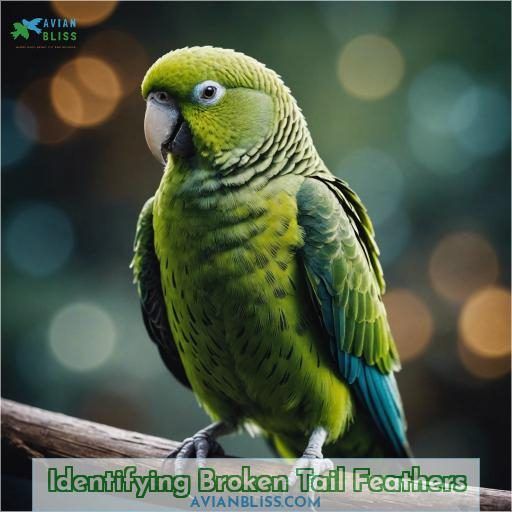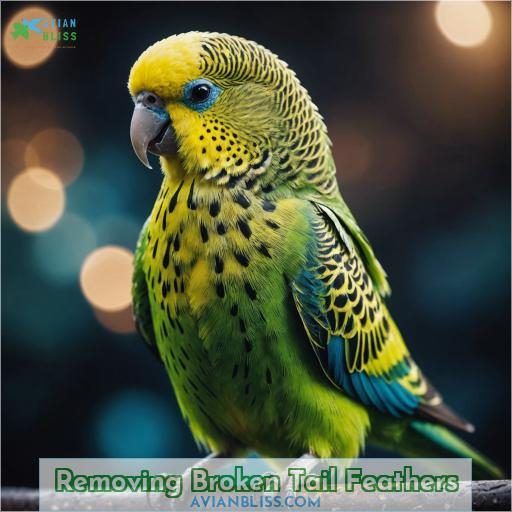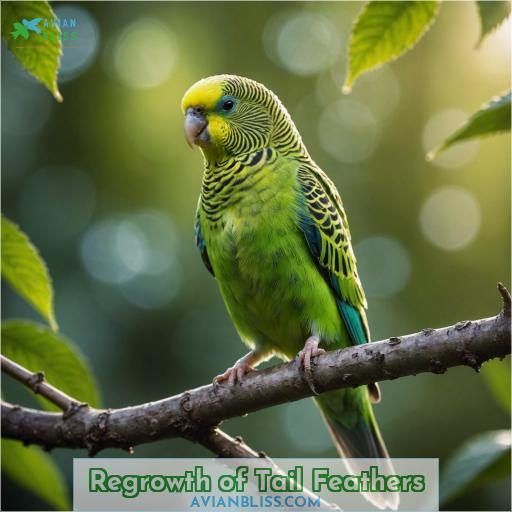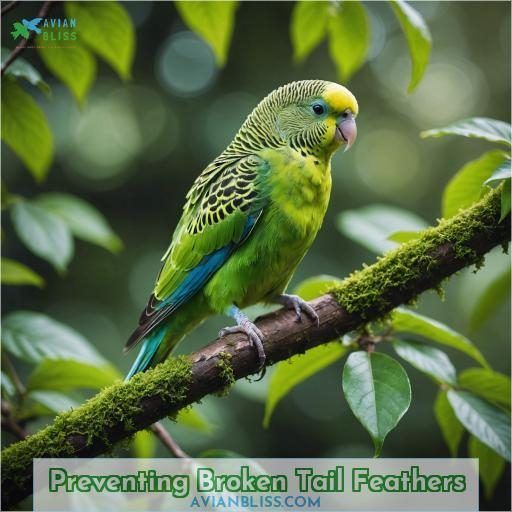This site is supported by our readers. We may earn a commission, at no cost to you, if you purchase through links.
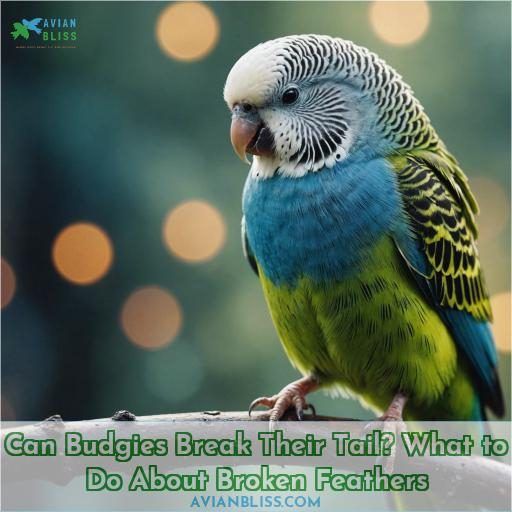 Yes, budgies can break their tail feathers quite easily. These feathers are fragile and vulnerable to various mishaps.
Yes, budgies can break their tail feathers quite easily. These feathers are fragile and vulnerable to various mishaps.
Clumsy young birds or accidental snags can cause breakage, as can rough handling during grooming or molting. If you notice bent, broken feathers or bleeding, it’s essential to seek veterinary help immediately.
Don’t attempt removing broken feathers yourself, as improper extraction risks further injury. With proper care, including a safe environment and regular nail trims, you can minimize the chances of your budgie breaking its tail.
To learn more about identifying, treating, and preventing this issue, read on.
Table Of Contents
Key Takeaways
- Budgies’ tail feathers are fragile and vulnerable to accidental snags, rough handling, or clumsiness, which can lead to breakage and bleeding.
- If you notice broken or bleeding tail feathers, seek immediate veterinary assistance. Do not attempt to remove broken feathers yourself, as improper extraction can cause further injury.
- With proper care, including a safe environment and regular nail trims, you can minimize the chances of your budgie breaking its tail feathers.
- Broken tail feathers will naturally regrow during the molting process, but providing a nutrient-rich diet and a calm environment can support healthy regrowth.
Can a Budgie Break Its Tail?
Yes, a budgie can break its tail feathers. Broken tail feathers in budgies are relatively common and usually result from the bird getting its tail caught or from feather picking behavior.
Causes of Broken Tail Feathers
As a budgie owner, it’s important to understand the common causes of broken tail feathers. Budgies can inadvertently break their tail feathers due to clumsiness, clipped wings, the natural molting process, or accidental breakage in their environment.
Clumsiness in Young Birds
As young budgies explore their world, their boundless energy and developing agility can sometimes lead to accidental tail feather breakage. Though their feathers are still gaining strength, close observation and a budgie-safe environment can help prevent mishaps. With a few precautionary measures, you can keep your hand-reared budgie’s tail intact and healthy.
Clipped Wings
Clipped wings can contribute to broken tail feathers in your budgie. While this may prevent flight, the clipped feathers can still get caught and damaged. Though the broken feathers may shed naturally, new feathers will grow in with a blood supply, requiring careful monitoring to prevent bleeding. Stay vigilant during this feather replacement process.
Natural Molting Process
As your budgie ages, its feathers will naturally shed and regrow during the molting process. This causes the existing tail feathers to loosen and fall out, allowing new feathers to emerge from the follicles. While this can result in a temporary disheveled appearance, it’s a normal part of your budgie’s life cycle.
- Feather structure made of keratin
- Follicle damage triggers new growth
- Growth takes several weeks
- Molting follows a seasonal schedule
- Gentle grooming supports feather hygiene
Accidental Breakage
Accidents happen, even for our feathered friends. Broken tail feathers can occur if a budgie gets tangled or takes a tumble. Keep their living space safe with secure perches and ample room to move. Trim nails regularly to prevent snagging. With a little TLC, those tail feathers will grow back, good as new!
| Causes of Broken Tail Feathers | Prevention Tips |
|---|---|
| Clumsiness in young birds | Provide a spacious, obstacle-free cage |
| Snagging on cage bars or perches | Regularly trim your budgie’s nails |
| Accidental falls or collisions | Supervise out-of-cage time |
| Rough handling during grooming | Consider a flight cage for more room |
| Molting and natural feather loss | Gently smooth down any bent feathers |
Identifying Broken Tail Feathers
If you observe your budgie’s tail looking crooked or fractured, coupled with observable blood seepage and distressed vocalizations, it’s probable that a tail feather is broken. Reacting promptly to accurately pinpoint and manage the problem is essential for maintaining the wellbeing of your feathered companion.
Appearance of Bent or Broken Feathers
When checking your budgie’s tail, you may notice some bent or broken feathers. These could be the result of clumsiness, molting, or even accidental damage. Take a close look at the feather shape, color, and texture – any irregularities could indicate an issue needing attention. Regular feather grooming and trimming can help prevent future problems.
Presence of Blood Flow
Uh oh, looks like there’s some blood flow happening! That could mean a broken blood feather is causing a clot. Don’t try to remove it yourself – that could make things worse.
Instead, grab some cornstarch from your first aid kit and gently apply it to the area to help stop the bleeding.
Get to an avian vet fast, they can properly assess and treat the injury.
Noise of Pain Heard
If your budgie is emitting distressed noises, it may indicate a serious injury like a broken tail feather. This sudden change in behavior is a clear sign something is wrong. Remain calm and examine your bird closely, looking for any signs of bleeding or feather damage. Swiftly moving to address the potential emergency is vital.
Significant Amount of Blood
If your budgie’s chest is soaked in blood, this is a grave emergency. Avoid attempting to remove any clots yourself – instead, locate the corn starch and administer it to the wound to halt the bleeding. Subsequently, transport your feathered companion to the veterinarian without delay. Prompt medical intervention is imperative for a severed blood feather.
Removing Broken Tail Feathers
It’s imperative to seek immediate veterinary attention if your budgie’s tail feather is broken and bleeding. Your avian veterinarian can skillfully remove the damaged feather and apply styptic powder or solution to halt any ongoing bleeding, mitigating the risk of further harm.
Importance of Veterinary Intervention
When your budgie’s bleeding from a broken tail feather, don’t try removing the clot yourself – that’s best left to the experts. Instead, get them to an avian vet right away. They’ll know how to safely remove the damaged feather and stop the bleeding fast, preventing further injury. Time is of the essence, so don’t delay seeking professional care.
Careful Extraction to Avoid Further Injury
You’ll need to carefully extract the broken feather shaft to prevent further feather damage, blood loss, or pain. An avian veterinarian can safely remove it, but with caution, you can do so by:
- Gently restraining your budgie
- Slowly pulling the shaft in its natural direction
- Applying cornstarch to stop any bleeding
Seek veterinary care if there’s excessive bleeding or signs of infection. Proper extraction minimizes trauma for your feathered friend.
Use of Styptic Powder or Solution
You’ll want to use a styptic powder or solution to help clot the blood and stop the bleeding. These home remedies, often made with aluminum compounds, provide rapid clotting benefits when applied with firm pressure. Styptics additionally stanch bleeding and can help prevent infection by sealing the broken feather shaft.
Monitoring for Ongoing Bleeding
After removing the broken feather, monitor closely for ongoing bleeding. You’ll want to:
- Apply styptic powder or solution to the feather follicle
- Use clean gauze to apply firm pressure
- Watch for fresh blood seeping through
- Be prepared to seek veterinary care if bleeding persists
The goal is to stop the blood supply and allow natural molting to occur. With diligence, the feather will regrow properly.
Regrowth of Tail Feathers
Broken budgie tail feathers will naturally regrow during the molting process as their feathers are continually replaced. As the new feathers emerge from the follicle, provide a nutritious diet and proper care to support healthy regrowth, as the temporary bent or misshapen appearance will resolve over time.
Feather Composition and Follicle Regeneration
Feathers are made of keratin, a fibrous protein that grows from follicles like our nails.
If a feather is damaged or broken, don’t worry – it’ll regrow from the follicle in due time.
Proper feather care, including trimming and maintaining their health, ensures your budgie’s plumage stays lush and vibrant.
Feather loss, however, may indicate an underlying issue requiring veterinary attention.
Temporary Bent or Misshapen Appearance
As the damaged tail feathers start regrowing, you’ll notice their bent or misshapen appearance due to the follicle damage. Don’t worry though, this is just temporary:
- New feathers take time to reach their full keratin composition
- The bent look arises from interrupted feather integrity
- Providing supportive care aids regrowth and molting
- A little patience goes a long way during this phase
The bent appearance is short-lived as budgies naturally replace their tail feathers.
Natural Molting and Replacement
While it’s concerning to see a broken tail feather, don’t fret—it’s part of a budgie’s natural molting process. The damaged feather will eventually fall out, and a new one will grow in its place. However, if there’s active bleeding, you’ll want to gently remove the broken feather, taking care not to further harm your feathered friend.
| Feather Care | Proper Handling | Natural Molting |
|---|---|---|
| Monitor bleeding | Avoid pulling intact feathers | Know molt cycles |
| Styptic powder if needed | Seek vet help if unsure | New feathers will grow |
| Provide calm environment | Handle minimally | Part of healthy bird life |
Providing Supportive Care During Regrowth
While your budgie’s tail feathers regrow, provide supportive care:
- Gently clean any dried blood and keep the area clean
- Offer a nutrient-rich diet with protein for feather development
- Minimize stress through a calm, quiet environment
- Bond through daily interaction, handling, and socialization
With patience and proper care, your feathered friend will soon sport a brand new, healthy tail.
Preventing Broken Tail Feathers
To prevent broken tail feathers in your budgie, you’ll want to make sure a safe and spacious environment. Regularly trimming your budgie’s nails will also help avoid snags on cage bars that could lead to feather damage.
Ensuring a Safe and Spacious Environment
You’ll want to provide a roomy cage, placing perches far from wires or other hazards. Make sure there’s vertical spacing between levels to prevent accidental falls. Offer plenty of toys and greenery for mental enrichment and natural behavior. With a safe, engaging setup, you can minimize the risk of your budgie snapping tail feathers from clumsiness or boredom.
Regular Nail Trimming to Avoid Snagging
Regular nail trimming is vital for maintaining your budgie’s nail health. Neglecting nail trimming allows nails to grow excessively, increasing the likelihood of entanglement with cage bars, leading to:
- Broken feathers
- Injury
- Pain
- Distress
Maintain nails at an appropriate length and smooth shape. This basic care measure prevents painful snags that can damage delicate tail feathers and cause bleeding.
Supervised Out-of-Cage Time
You’ll also want to supervise your budgie closely during out-of-cage time. Create a safe play area with perches positioned to avoid falls. By keeping a watchful eye, you can intervene if your feathered friend starts climbing or playing too recklessly, potentially leading to broken tail feathers.
Consideration of a Flight Cage
You might consider getting a flight cage for your budgie. These spacious cages provide ample room for your feathered friend to stretch their wings and move about freely, reducing the risk of broken tail feathers due to cramped quarters. A flight cage creates a safe, open environment where your budgie can explore without bumping into obstacles or getting injured.
Frequently Asked Questions (FAQs)
Can budgies lose their tail feathers naturally?
Yes, budgies can molt and lose their tail feathers naturally. It’s a normal part of their annual feather cycle. You’ll find discarded feathers around their cage during these molting periods as new feathers grow in.
Is a broken tail feather painful for budgies?
Imagine your budgie landing awkwardly, and its tail feather snapping. Yes, a broken tail feather can be quite painful for these little birds. The feather’s blood supply makes it excruciatingly sensitive when damaged. Seeking prompt veterinary attention is essential for proper treatment and relief.
How long does it take for new tail feathers to grow?
You can expect new tail feathers to grow in within 6-8 weeks for a budgie. The feather regrowth process takes time, but it’s a natural cycle for birds to replace damaged feathers during their molt.
Do broken tail feathers affect a budgies ability to fly?
Yes, broken tail feathers can temporarily affect a budgie’s ability to fly and balance. However, they’ll regrow with the next molt, restoring normal flight.
Are certain budgie behaviors more likely to cause tail feather breakage?
Yes, certain behaviors like climbing, flapping wings excessively, or getting caught on cage bars can increase the risk of breaking a budgie’s delicate tail feathers. Providing a safe, spacious environment helps minimize this.
Conclusion
Ultimately, while a budgie breaking its tail feathers can be distressing, prompt veterinary care and a safe environment can guarantee a full recovery. Remember, your feathered friend can break its tail, so remain watchful, provide a hazard-free habitat, and address any broken feathers immediately. With proper precautions and treatment, your budgie’s vibrant tail will soon regain its former glory.


